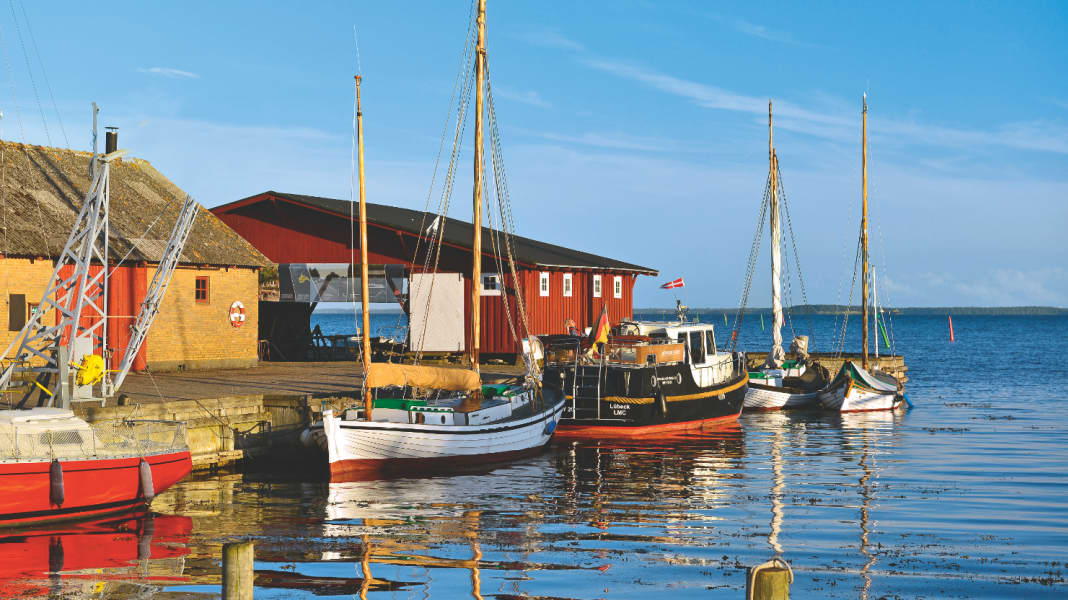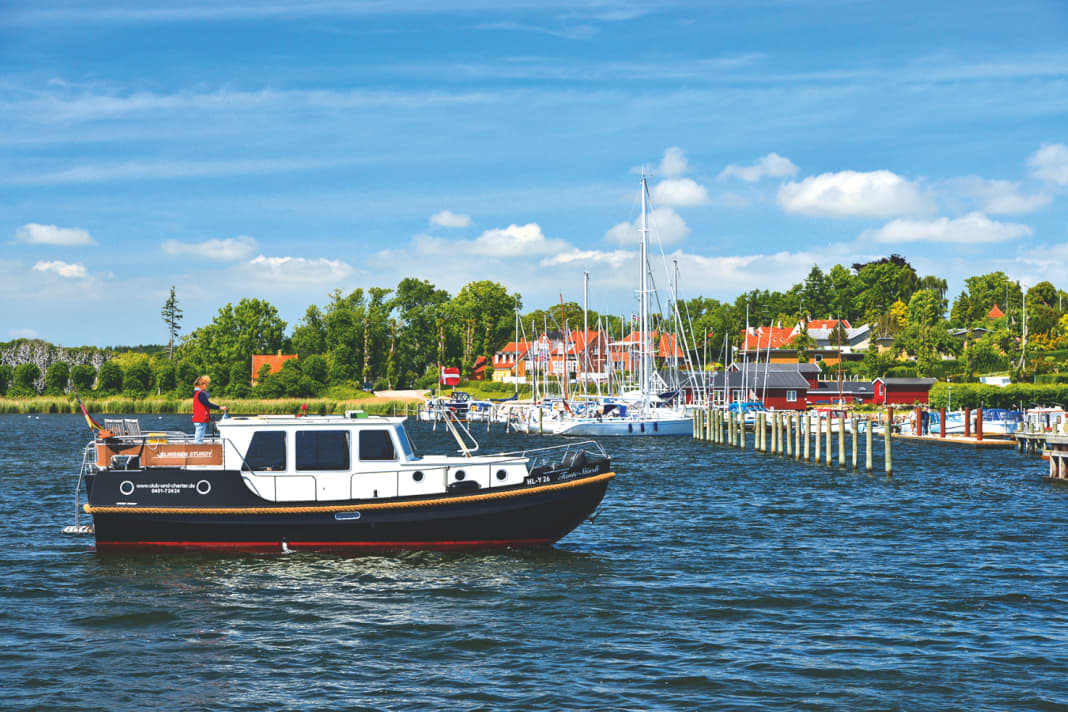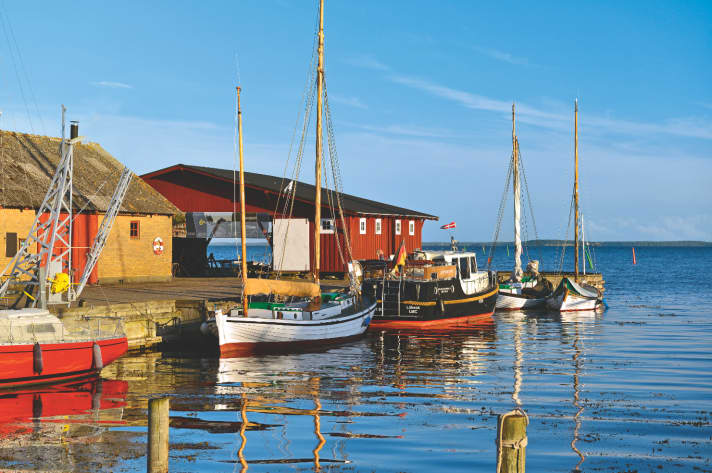
The first part of the report from Bagenkop via Sønderborg to Ærøyou can find here.







The journey continues to Rudkøbing on Langeland. The trip from Marstal to the west coast of the island leads through narrow, buoyed fairways and is an experience for anyone who enjoys cruising. The wind blows from the east for a change and the sea is a little rough. But in the cover between the small islands south of Funen and Langeland, not much swell can build up. The Langelandsbroen stretches right ahead. The 771 metre long and 26 metre high road bridge connects Langeland with the small island of Siø and thus with Funen via Tåsinge.
Late in the afternoon, we head for Rudkøbing marina and stock up on diesel and water. We would love to stay longer in this pretty little town. But the weather forecast announces that the wind is set to pick up and turn south. We want to cross the Great Belt to the east tomorrow. So it would be a good idea to sail to the northern tip of Langeland today so that we can cross the Great Belt as early as possible tomorrow with as little wind as possible.
The only safe harbour in the north of Langeland is Lohals. We moor in the municipal harbour, where yachts are moored alongside fishing boats and traditional sailing vessels. The houses dotted around the landscape seem to be hiding in the dunes. We go alongside behind a wooden gaff loop. The bearded skipper, who could slip into the lead role of a Viking film without his mask, takes the lines, nods in a friendly manner and discreetly retreats on board his floating, wooden construction site. - We ask him where we can get something to eat, but are disappointed: "The 'Havne Grillen' is still closed. And you'll be too late at 'Lohals Kro'. It's just before nine o'clock. You should have made a reservation," he says. We make long faces. But he has another idea:
"Have you got any bread? Maybe some beer or wine? Then sit here on the bench on the pier and enjoy the most beautiful sunset in the world," is his advice. We rummage in the fridge, set the table on the pier and invite the grey-bearded Dane: "My friends call me Röde Orm," he introduces himself.
introduces himself. "Like the hero of Frans G. Bentsson's novel?" I ask without much surprise - the name just fits. "Yes, that's right. I'm one of the last Vikings of Langeland. I was on the Viking expedition in Upernavik last year with this ship - he points to his wooden sloop. Do you know where that is?"
I pour the Nordmann some Baden Pinot Blanc and take a little guess: "Upernavik? Do you mean the little town on the west coast of Greenland?" - I'm spot on! His eyes light up and he toasts me: "Yes, right there. Three thousand nautical miles from here," he says proudly. "And where is the most beautiful place in the world for such a well-travelled Viking son?" I want to know. "Well, here of course: in the Danish Southern Sea!"
In the morning, as expected, the wind has shifted to the south, but is still relatively calm. We set off early in order to cross the Great Belt, one of the busiest shipping lanes on the way to the North Sea, while the sea is still calm. As the Belt runs straight from north to south, the jet effect can create winds and swell that can be unpleasant, at least for small boats.
Our destination is the Smålands fairway, a large bay north of Lolland with several small islands. On the way there, we have to sail around 13 miles diagonally from north-west to south-east across the Belt. By ten o'clock we're about halfway across. However, the wind has steadily increased and has now reached five Beaufort. A wave a good metre high hit us from the side, but our Linssen put up a good fight. However, neither the boat nor the crew should be expected to cope with much more wind and swell. Finally, we are glad when we enter the Småland fairway around midday and get more and more cover there.
We round the southern tip of the small island of Fejø and head for Dybvig harbour from the south. The approach is extremely narrow, but well buoyed. The southerly wind blows us from astern right into the fairway. To avoid drifting sideways, we also have to accelerate hard. The pairs of buoys whizz past us so close that we could touch them with our hands. Then we enter the harbour. Due to the narrowness and the strong wind, it is a bit of a challenge to turn the boat on the spot. But where to moor? The few berths are full.
A friendly Dane climbs into his clinker-built sailing cutter and frees up his berth for us by putting his boat alongside the neighbouring boat. He then helps us to moor. We are thrilled by so much hospitality.
Dybvig harbour and the entire island of Fejø is a picturesque gem. A 20-minute walk takes you to the idyllic village of Fejø, where there is a restored windmill where the friendly miller offers home-baked cakes. On the main street, Herredsvej, there is a small shop and the "Kro Kvasen". The inn offers a service that seems to be unusual for Denmark: you pay 128 kroner (17 euros) per person and can then eat your fill at an extensive buffet - from fish, meat and salads to coffee and cake.
But as beautiful as it is in Fejø, the zenith of our charter week has passed and we have to turn our bow back towards home. We want to use the Guldborg Sound between the islands of Lolland and Falster for this. The journey from Fejø through the Småland fairway to the northern entrance to Guldborgsund leads through a nautically challenging area. There are relatively many shallows and the fairway is only buoyed at the really critical points.
However, the Guldborgsund itself provides us with a picturesque cruise, as the persistent strong wind from the south cannot do much. In the afternoon, we make a stopover in Nykøbing. In the new Slotsbryggen harbour, we find a berth in a modern complex surrounded by new flat blocks. From here, the picturesque alleyway "Gammel Toldbod" takes us to the picturesque old town centre in just a few minutes. Nykøbing has a lovely pedestrianised area around the monastery church and water tower. We would have liked to stay overnight, but we have to return our boat tomorrow evening.
So we decide to continue at least as far as Nysted, which is at the southern end of the Guldborg Sound. As long as we are protected by the land cover, the southerly wind doesn't hurt us. The waves come right up against us, but they are flat and hardly slow us down. The southern part of Guldborg Sound widens into a lagoon, which is somewhat protected from the waves of the Baltic Sea by the Rødsand sandbank.
However, swell has already built up on the lagoon itself, making it increasingly difficult for our Linssen to make headway. After passing the Flinthorne shoal buoy, we turn 90 degrees to starboard to head for the fairway to Nysted. We suspect that we are in for some unpleasant broadsides. Before we change course, we secure ourselves with lifebelts.
We set a westerly course at the shoal buoy. The first full broadside buries our Linssen under a shower of cold Baltic Sea water and she starts to roll and pitch. We reduce speed. This makes it easier to maintain our course and the ship's movements are not so extreme. To make matters worse, it also starts to rain. It's only five nautical miles to Nysted, but that can be a long way in this weather.
The buoyed fairway ends abruptly and you think you can't go any further. However, a very narrow fairway follows, marked with such tiny buoys that it is barely recognisable in the evening light in "shifty weather". We feel our way forwards metre by metre, with the channel turning to the north so that at least we no longer encounter any unpleasant broadsides. As if in mockery, the water in the bay of Nysted is almost smooth again and it stops raining. Only the moving treetops show that the world out at sea looks different.
We find a berth in the old town harbour, which is currently being converted into a marina. Right next door is the "Røgeriet" restaurant, where shaken South Sea travellers can warm up again with fish soup and tea and watch the sunset from the glassed-in terrace.
In the morning, we see that the small town of Nysted has been beautifully spruced up. The old harbour is still being redesigned - everything should be ready by the summer. Unfortunately, one of the town's former attractions, the 13th century moated castle of Aalholm, can no longer be visited. The car museum, once the most valuable private car collection in Europe, no longer exists either. In July 2012, the 220 luxury cars, some of which were over a hundred years old, went under the hammer.
The wind and swell gradually died down during the night. Only a weak swell rolls across the Baltic Sea from the south to Lolland. In Nysted, we fill the tanks of our "Tante Stördy" to the brim again in the morning. By midday, there should be no wind and the sun should be shining again. Where yesterday the seas were still rolling against our broadside, a mirror-smooth sea awaits us. In front of us is the Nysted Havmøllenpark Rødsand, currently the world's largest offshore wind farm with 72 rotors around 110 metres high. The funny thing is that the fairway runs diagonally through it.
In beautiful sunshine and a light westerly wind that sweeps the last rain clouds from the sky, we head south-west across the Baltic Sea towards Travemünde. The Danish archipelago remains behind in the north - and the memory of a beautiful sailing area with friendly people.
FURTHER INFORMATION
Charter company For the 2007 season, Martin Stratmann started Club + Charter with his first Linssen yacht, a Grand Sturdy 29.9 AC, at his jetty in Lübeck's Old Town. In the meantime, two larger boats have been added, a Classic Sturdy 35 AC and a Grand Sturdy 380 AC. Today, Stratmann also organises trips to more distant areas, including crew changes. The yachts can be chartered for trips on inland waterways as well as at sea. Since 2013, the charter company has also offered Marina Neuhof near Stralsund as a base harbour for the waters around Rügen. Information and booking: Club + Charter, Wallstr. 57, 23560 Lübeck; Tel. 0451-724 24. www.club-und-charter.de
Boat
The Linssen Classic Sturdy 35 AC we sailed has two separate double cabins with en-suite bathrooms. A spacious and comfortably equipped galley and a cosy saloon with heating ensure comfortable living. Technical equipment: inside and outside steering position, bow thruster, VHF radio for inland and sea, autopilot, GPS, chart plotter, depth sounder, log, 200 W inverter. Although the ship is not the youngest, having been built in 1995, it was visually and technically in top condition.
Technical data
Length 10.75 m; width 3.55 m; draught 1.15 m; engine Volvo Penta 96 kW (131 hp); water tank 220 l; diesel tank 440 l. Consumption: 4.5 l/h at 2000 rpm (5.5 kn), 10 l/h at 3500 rpm (8.5 kn).
Prices
The Classic Sturdy 35 AC costs between 1050 and 1790 euros per week, depending on the season. Deposit: 750 euros. Diesel is charged according to consumption.

